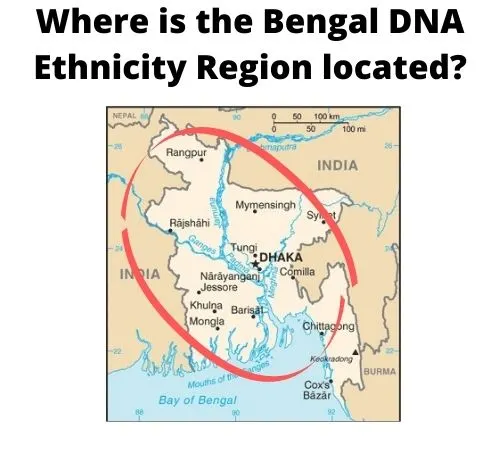Do you want to know what the Bengal DNA Ethnicity Region on Ancestry is? In this post, learn about this region and how you may have inherited it from your ancestors.
Those individuals with ancestry in the Bengal region are in excellent company. There are an estimated 12-13 million people with roots in the region in more than 30 countries around the world, with nearly 1 million of those individuals of Bengal heritage living in the United States.

In this post, you will learn:
- Where the Bengal DNA Ethnicity Region is located
- In which countries you are likely to find Bengal DNA
- How you may have inherited DNA matching the Bengal region
- How to trace your Bengal ancestors
Whether you are surprised to find this region in your results, or it was expected, you are sure to learn something new about your family tree through exploration of your Ancestry DNA results.
Where is the Bengal DNA Ethnicity Region located?
The Bengal DNA ethnicity region is located in Asia on the Bay of Bengal, surrounded by India to the north, east, and west. This region has a rich history extending back to ancient times.

The location of the Bengal region on the Bay of Bengal led to the development of a maritime trade system. Furthermore, both ancient and modern political powers in the Bengal region have been able to leverage the strategic geographic position for economic and military gain.
In which countries can you find Bengal DNA?
The primary country where you are most likely to find people whose DNA matches the Bengal DNA region is Bangladesh. However, people who have deep ancestry in areas with a geographic proximity to Bangladesh, including parts of India or Bhutan, might find that they share a genetic connection with the Bengal DNA region.
Which sub-regions are in the Bengal DNA region on Ancestry?
Currently, there is only one sub-region under the broader Bengal DNA region. The single sub-region is Bangladesh.
If you have very recent ancestry from Bangladesh region, you may have received this sub-region on your results. It may look something like this:

If you know that your ancestors were from Bangladesh, yet you did not receive this sub-region, don't worry. It is normal to have ancestry from a main region (such as Bengal) and yet not match a sub-region.
It is likely that more sub-regions will be added over time. If a new region is added and your DNA matches that region, it will show up automatically on your updated results.
Ancestry DNA updates results regularly, so be sure to check back periodically to see if any new regions show up for you.
How did you get Bengal DNA?
Everyone inherits 50% of their mother and father's DNA, which means that DNA matching the Bengal region was passed down from one parent, or both. While many people might know that they have ancestry in the Bengal region of Asia, others might have been surprised to see it in their ethnicity estimate.
Below, I will describe a few different scenarios that could help you decide how to go about researching your Bengal ancestors. These different situations will be most helpful to those who were not expecting to find ancestry matching the Bengal region in their DNA results.
Your Bengal DNA region may be from an ancestor from a nearby region
If you have known ancestors in your family tree from an area immediately adjacent or relatively close to the Bengal DNA region, you may have inherited your DNA matching this area through them.
Our distant ancestors, no matter where they lived, did not have access to airplanes, cars, and trains. Thus, traveling was much more difficult for them.
However, this does not mean that they did not travel. In fact, humans have always migrated from place to place - it's just simply something that we have always done.
You may have inherited DNA indirectly through ancestors who migrated away from the Bengal region
As I mentioned towards the beginning of this article, there is a large diaspora of people whose ancestors migrated away from the Bengal region. Many families have migrated away from this area to North America, Europe, and other parts of Asia.
If your Bengal ancestors left the region generations ago, you may have inherited DNA matching the region through what we sometimes call a "third country". For example, an ancestor leaving Bangladesh starts a family in the United Kingdom, and descendants of that ancestor take an autosomal DNA test in the United States several generations later.
There are records of migrants arriving to England (what is now the United Kingdom) from what we now know as Bangladesh centuries ago. Many of these individuals worked on ships and ended up living in cities with large ports, and some of these workers started families with wives from the local English communities.
How to trace your ancestors from the Bengal region?
The first step in tracing your Bengal ancestors will begin with you, your parents and grandparents. It is important to learn as much as you can about your immediate ancestors because you will find important clues about your more distant ancestors during the process.
As you learn more about your family, be sure to document everything that you discover by taking careful genealogy notes and adding details to a family tree (you can build one for free on Ancestry). Eventually, you will probably need to take to the internet to see if you can find records about your ancestors.
While searching for genealogy records such as vital records pertaining to births in the Bengal, it is important to keep the following in mind.
Birth registration records may be difficult to locate
It was made compulsory to register births in Bangladesh towards the end of 2006, which means that births that occurred prior to this date may not be registered. In rural areas, registration was less common, so it may be more difficult to find these types of records for ancestors who lived in smaller towns and villages.
If your more recent Bengal ancestors lived in bigger cities, or lived in a third party country where birth registrations were more prevalent, then you may be able to locate these documents. Birth records are kept at the local levels in the seven administrative districts of Bangladesh, yet some are available online, which I discuss a bit more below.
Territories involving Bangladesh, India, and Bhutan have shifted over the past century
The Bengal region, which as you know encompasses Bangladesh, as well as small portions of India and Bhutan, has gone through several important political shifts beginning in the British Colonial period. However, the changes most relevant to those individuals of Bengal descent interested in learning about their ancestors are the changes that occurred since the beginning of the 1900s.
The country that is now Bangladesh was once called East Bengal, then East Pakistan, which was part of a larger Pakistan. After the establishment of the People's Republic of Bangladesh in 1971, many (but not all) records from the former East Pakistan were transferred to the corresponding local authorities.
The best way to know exactly where to look for documents that pertain to your Bengal ancestors is to follow the steps above in order to learn as much as you can about your more recent ancestors. Ideally, you can discover exactly where your ancestors were living within the broader Bengal region, which will be key in finding out where you might be able to find genealogy records.
Conclusion
I hope that this post has helped you understand more about your ancestry from the Bengal region of Asia, how you may have inherited DNA matching this area, and how to learn more about your ancestors who lived there.
If you have any questions about something that you read in this post, or if you would like to add something to the discussion, please leave a comment below.
Thanks for stopping by today!
